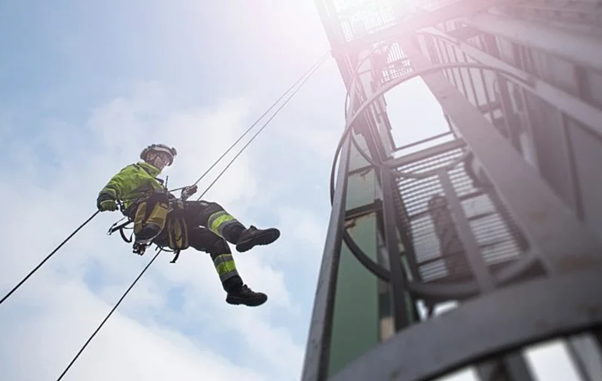Industrial rope access systems have revolutionised the way we access and work at elevated heights in various industries. From construction and maintenance to inspection and rescue operations, this technique has proven to be efficient and effective. However, the success of industrial rope access heavily relies on the proper selection, maintenance, and usage of essential equipment. Without appropriate equipment, workers’ safety can be compromised, and operational efficiency can be significantly hindered.
This article will delve into the comprehensive understanding of the essential equipment required for effective rope access systems. From harnesses and ropes to anchors and safety gear, it will explore each component, its significance, and the best practices in inspection and maintenance. By the end, you will have a clear understanding of how crucial equipment is to ensure a safe and productive rope access operation.
Technical Equipment
A. Harness
Harnesses are fundamental components of industrial rope access systems, serving as a crucial link between the worker and the ropes. There are various types of harnesses designed to accommodate different body types and work requirements. The proper fit and adjustment of harnesses are essential to prevent discomfort and ensure optimal safety during rope access operations. Workers must be trained to select and adjust harnesses that best suit their individual needs.
B. Rope
The selection of ropes is critical in industrial rope access, with considerations such as dynamic versus static ropes, load capacity, and elongation characteristics. Regular inspection and maintenance of ropes are essential to identify signs of wear and tear, abrasion, or chemical damage that may compromise their strength. Proper storage and handling of ropes also contribute to their longevity and reliability during rope access operations.
C. Descenders
Descenders play a crucial role in controlling the descent of workers during rope access activities. Various types of descenders are available, each with specific features tailored to different applications. Workers must receive comprehensive training in the usage and safety considerations of descenders to ensure controlled and safe descents at all times.
D. Ascenders
Ascenders are essential for ascending ropes during industrial rope access operations. These devices enable workers to move vertically with ease and control. Understanding the types of ascenders available and their proper use and maintenance is essential for the safe and efficient traversal of vertical surfaces.
Rigging Equipment
A. Anchors
Anchors serve as the primary attachment points for ropes and are critical components in the safety and stability of industrial rope access systems. Different types of anchors are available to accommodate various surface conditions and load requirements. Regular inspection and proper selection of anchor points are essential to ensure the structural integrity and safety of the anchor systems.
B. Connectors
Connectors, such as carabiners, form the link between different elements of the rope access system. They play a vital role in ensuring secure connections and transitions between ropes, harnesses, and other components. Regular inspection and maintenance of connectors are essential to identify signs of wear, distortion, or stress that may compromise their reliability.
C. Rigging Plates and Pulleys
Rigging plates and pulleys are utilised to create efficient rigging systems and redirect rope pathways during industrial rope access operations. Understanding the different types of rigging plates and pulleys and their application is crucial for creating safe and efficient rope rigging configurations. Proper maintenance and inspection of these components are essential to avoid unexpected failures during operations.
Safety Equipment
A. Helmets
Helmets are essential in providing head protection during industrial rope access operations. They act as a vital defence against falling objects and impacts in elevated work environments. Understanding the importance of helmets, adhering to helmet standards, and integrating proper maintenance practices are crucial for ensuring the safety and well-being of workers.
B. Personal Protective Equipment (PPE)
In addition to harnesses and helmets, the integration of personal protective equipment (PPE) is essential in industrial rope access systems. Proper selection and usage of PPE, along with adherence to maintenance practices, contribute to the overall safety of workers operating at height. Harnessing PPE correctly is crucial for providing optimal protection and maintaining worker safety throughout rope access activities.
C. Fall Protection Devices
Fall protection devices, including lanyards and self-retracting lifelines, play a critical role in preventing falls and controlling descents during rope access operations. Understanding the types of fall protection devices available, their proper usage and the necessity of regular inspection contribute significantly to the safety and confidence of workers while performing at elevated heights.
Inspection and Maintenance Protocols
Establishing inspection and maintenance protocols for industrial rope access equipment is paramount to ensure the ongoing safety and reliability of the system. Regular equipment inspections, adherence to recommended maintenance schedules, and the implementation of comprehensive training and certification for equipment inspection are essential to identify and address any potential issues before they compromise worker safety.
Conclusion
Industrial rope access systems rely heavily on the proper selection, maintenance, and usage of equipment to ensure the safety and efficiency of workers operating at height. Understanding the technical equipment, rigging components, safety gear, and the significance of inspection and maintenance protocols is essential for the successful implementation of industrial rope access systems. Adhering to best practices in equipment usage and maintenance underscores the commitment to promoting a safe and secure work environment for rope access operations across diverse industries.




